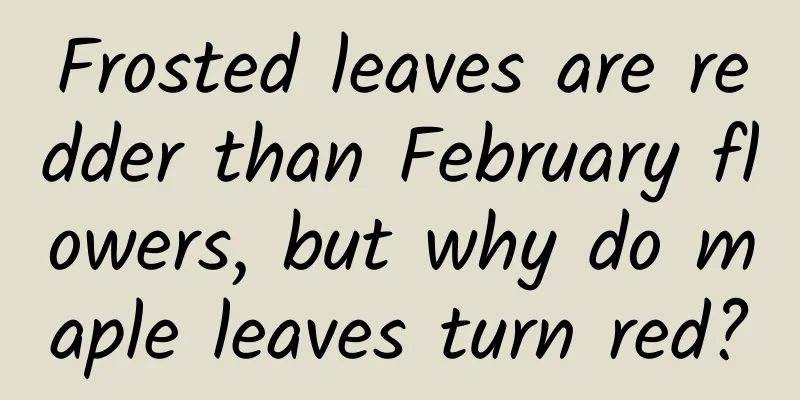Frosted leaves are redder than February flowers, but why do maple leaves turn red?

|
Why do maple leaves turn red? Uncover the mystery of nature's amazing phenomenon When we walk along the forest trails in autumn, we can always see red maple leaves. They sparkle in the sunlight, covering the earth with a golden red brilliance. So why do maple leaves become so beautiful in this season? This article will reveal the secrets of this wonderful phenomenon of nature. First, we need to understand the growth habits of maple trees. Maple trees are deciduous trees native to temperate regions of the Northern Hemisphere. Maple leaves have five lobes, and the edges of each lobe have serrated textures. The bark of the maple tree is grayish white, and the trunk presents a graceful curve. Maple trees like to grow in an environment with plenty of sunshine and humid air. Therefore, in autumn, when the temperature gradually decreases and the daylight hours decrease, the growth rate of maple trees will slow down or even stop growing to save energy to survive the cold winter. So why do maple leaves turn red in autumn? This starts with the chlorophyll in the leaves. Chlorophyll is an important substance for photosynthesis in plants. It can absorb light energy from sunlight and convert it into chemical energy to provide energy for plant growth. However, chlorophyll is very sensitive to heat. When the temperature rises, the molecular structure of chlorophyll changes, causing it to lose the ability to absorb light energy. Therefore, in autumn, as the temperature drops, chlorophyll gradually decomposes and disappears, and other pigments that were originally hidden under the chlorophyll begin to appear. Among them, the most important pigment is carotenoids, which are divided into two types: orange-yellow carotene and yellow progesterone carotenoids. Both of these pigments make maple leaves appear yellow in autumn. However, in addition to carotenoids, there is another pigment called anthocyanin that also makes maple leaves red in autumn. Anthocyanin is mainly found in the vacuole of maple trees. It can absorb blue and red light, making maple leaves appear red. So why do maple leaves turn red? It turns out that this is related to another substance in the leaves called "abscisic acid". Abscisic acid is a plant hormone that can inhibit cell division and growth, causing plants to enter a dormant state. In autumn, the light hours decrease and the temperature drops, which causes the concentration of abscisic acid in maple leaves to increase. At the same time, the color changes of other pigments such as carotenoids and anthocyanins will also affect the color of the entire leaf. When these pigments work together, they make the maple leaves appear red. It is worth mentioning that not all types of maple trees turn red in autumn. For example, maple varieties in some regions cannot produce anthocyanins due to genetic mutations, so in the leaves of these maple varieties, only carotenoids play a role, making the leaves appear yellow or orange. In addition, some maple varieties produce both carotenoids and anthocyanins in autumn, making the leaves appear green or yellow. In short, the reason why maple leaves turn red in autumn is due to the decomposition of chlorophyll, the appearance of other pigments, and the combined effects of abscisic acid and other factors. This wonderful natural phenomenon not only brings us beautiful scenery, but also provides us with important materials for studying plant physiology and ecology. In future scientific research, we will reveal more secrets about the reddening of maple leaves. |
>>: Lin Yao | Reaching more possibilities through scientific research
Recommend
The five necessary stages for information flow delivery! Attached is an excellent case study in the gaming industry~
In 2017, legendary and fairy-tale games spent a l...
Tips you need to know about live streaming
In 2019, "Li Jiaqi" and "Viya"...
Water droplets "walking" on oil film, this is not science fiction! The secret of water droplets "dancing"
Your browser does not support the video tag Autho...
Human Confinement Experiment in Caves
Leviathan Press: Imagine if you were deprived of ...
Can WeChat chat screenshots be used as loan evidence? The judge reminded: Electronic evidence can be used, but pay attention to the following points
The Hangzhou Intermediate People's Court toda...
Have you ever seen the tentacles of microorganisms that can conduct electricity? Do you want one?
Produced by: Science Popularization China Author:...
Why is this tree's belly so round? Uncovering the "water storage legend" of South African plants
Have you heard of the "water storage legend&...
How to plan a successful and beautiful event?
As an operator, event promotion (event operation)...
Yibin SEO training: In what situations does the website need to use closed site protection
In the process of optimizing the website, if the ...
Durex was fined 810,000 yuan. How long will its “borderline” marketing continue to be popular?
If you walk by the river often, you will get your...
The first killer app for Apple Watch is born
1Password is a very useful password manager for c...
5 steps to operate Internet users!
As the link closest to users, user operations are...
This is a new type of fraud APP! Do not hesitate to uninstall it immediately
Recently, a new type of fraud software - "Un...
OnePlus completely closes offline stores: input costs and outputs do not match
After a year and a half, OnePlus finally returned...
Hot! Who grabbed the "ceiling among ceilings"?
"Who grabbed the 'ceiling among ceilings...









